
The Digital Equipment Corporation was a well-known and popular maker of computers during the 1960s and 1970s. They are credited with being the major force behind the minicomputer revolution.
The company was founded in 1957; its founders had the intention of making computers from the beginning, but first established experience in operating a profitable business of selling digital circuit modules, as required by the venture capitalist who made it possible for it to be created.
Their first computer was the PDP-1, a computer with an 18-bit word length that used one's complement arithmetic. The first one was shipped to a customer in November, 1960. The demonstration model included a built-in graphical CRT display in the console, but this feature was omitted from the production version, as most customers had not required it. That first machine was used at MIT, and the display allowed the famous game Spacewar to be programmed for it.
The front panel of the production version of the PDP-1 had the following appearance:

The next computer sold by DEC was the PDP-4. The front panel of this computer resembled that of the production version of the PDP-1. While it was made of ordinary lights and switches, instead of being rectangular, like most computer front panels, the edges were angled so as to produce a teardrop-like distorted hexagon.

This was a shape that would not have been out of place on a flying saucer in an old science-fiction movie, and, thus, from the very beginning, the idea that a computer should evince some design flair in order to look futuristic, as befits something at the peak of current technology, was part of the culture at DEC.
It was delivered initially in July, 1962. It was also an 18-bit computer, but the opcode field was four bits long instead of five bits long. As well, it had two versions of many instructions, one for one's complement arithmetic, and one for two's complement arithmetic.
Unlike the PDP-1, the PDP-4 had a number of compatible successors.
Its first successor, the PDP-7, shipping initially in December, 1964, had a relatively plain and unremarkable front panel.

The next successor, the PDP-9, although it had a front panel that was utilitarian enough not to be possible to accuse of being extravagant, was still appealing in appearance:

This machine was built from discrete transistors; its successor used integrated circuits.
But for a short time before that successor, the PDP-15, became available, a reduced-cost version of the PDP-9 was offered, the PDP-9/L. This computer, although derived from the PDP-9, had a completely different front panel, one with the same styling as would later be used for the PDP-15 and PDP-12. The diagram below shows the front panel flattened out; the top section with the lights is tilted slightly back from the vertical, and the botton section with the switches is tilted slightly down from the horizontal.
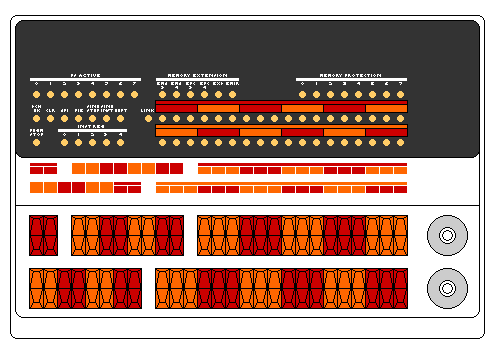
For comparison, to get an idea of how the system really looked, here is a photograph of the PDP-9/L from an advertisement:
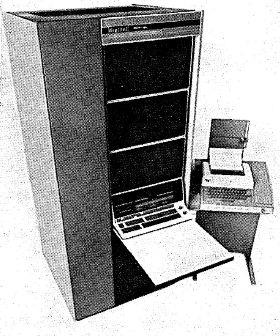
The PDP-9/L was quite short-lived; while 405 PDP-9 computers were manufactured, only 40 PDP-9/L computers were made, despite that system's lower cost.
The PDP-15 was first delivered in February of 1970. By this time, each of the different architectural lines of computer produced by DEC had its own distinctive color scheme.

The lower of the two knobs on the right was used to select which register to display in the lower group of eighteen lights. The upper knob, in addition to serving as the on/off switch, could also be used to cause the computer to operate at a slow rate.
A basically similar front panel, but with changed styling, was used on a relatively little-known machine called the XVM (for "extended virtual memory") which was a modified version of the PDP-15 with a wider address space; I had not heard of the existence of this computer until I saw what might be the last suriviving specimen, which had been purchased from a British government laboratory in Wales, on the web site of a collector:
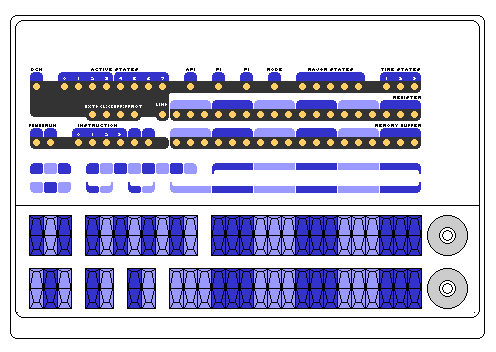
The PDP-5 computer was mentioned above. Its successor, the PDP-8, will be discussed on the next page. The PDP-5 was not the first computer to have a 12-bit word length. The very different CDC 160 computer also had a 12-bit word. Closer at hand, a system designed at MIT for data collection from experiments, the LINC, was influential. DEC assembled some LINC machines for its customers. Later, it brought out products which incorporated a LINC and a PDP-8 computer in the same chassis.
The first of them was the LINC-8,
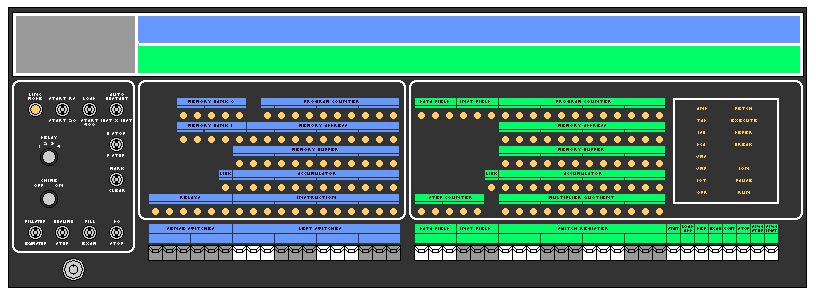
a machine contemporary with the PDP-9, that had green and light green switches, while the LINC section of the front panel placed the legends of the lights in blue bars and the PDP-8 section placed them in green bars. Thus, just as the PDP-9 and the PDP-15 did not use the same color scheme, neither did the LINC-8 and the PDP-12, but in this case, the LINC-8 was distinct from other DEC machines in color.
The next one was the PDP-12. This computer had a front panel very similar in styling, but different in color, from that of the PDP-15:

On the first page about front panels, two computers from the Digital Equipment corporation are illustrated, one of them being the version of the PDP-10 with the KA-10 chassis, the other being the PDP-8/I, both of which had the same styling of switch as used in the very similar front panels fo the PDP-9/L, PDP-12, and PDP-15. These switches were used on other items from DEC, such as their computer lab, an educational device for working with digital logic,
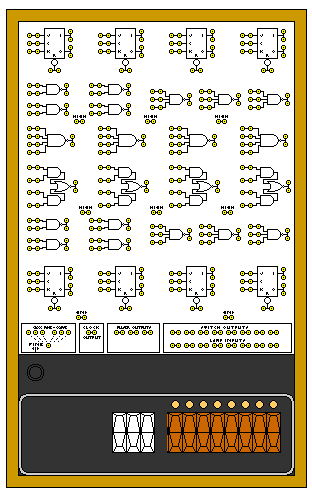
the m series logic lab which provided a framework and a front panel for PDP-16 setups, and the RK01 disk drive, among others.
The PDP-6, delivered in June, 1964.

was the first computer to feature the 36-bit architecture continued with the PDP-10 and the DECSYSTEM-20.
The original PDP-10 with the KA-10 chassis, and the front panel shown again below, was first delivered in September, 1967.
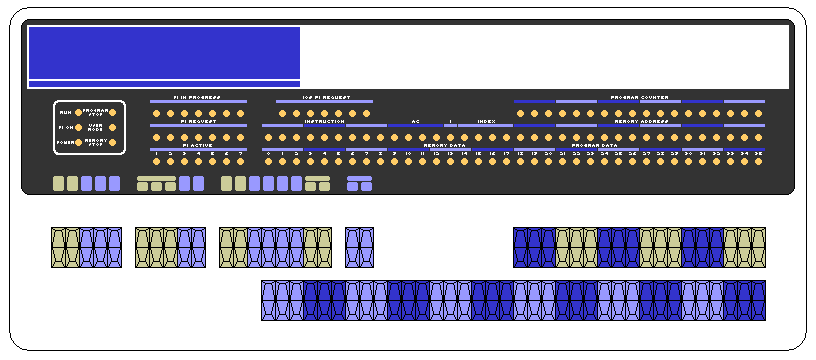
Once again, the diagram shows the front panel in a flattened-out form; here is a detail from a photograph in an advertisement to allow you to see what it really looked like:
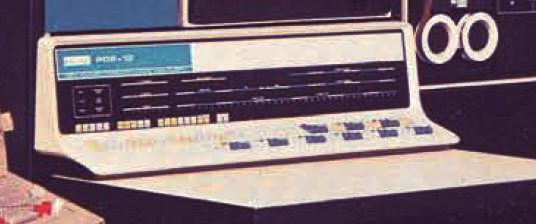
It was built from discrete transistors; its succesor, with the KI-10 chassis, which was first delivered in May, 1972, used Schottky TTL integrated circuits. It had a front panel as well,
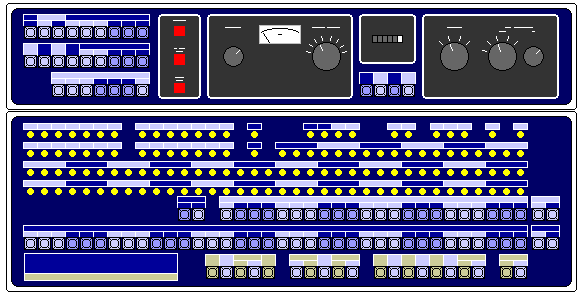
but the KL-10 chassis, delivered in June, 1975, did not, although it used a PDP-11/40 computer with a restyled front panel of its own as an I/O processor.
The KL-10 used ECL logic, which increased speed, but on the other hand it was microprogrammed, unlike the previous models with hardwired instruction logic. An enhanced version of the KL-10 CPU included the capability of using multiple address spaces of 256 K words.
The PDP-10 computer was well-loved by its users. It supported time-sharing well, it had a clean architecture with innovative features, such as the ability to handle characters of arbitrary size within its 36-bit word. The floating-point format resembled that of the IBM 7090, and many scientific programmers found the four extra bits of precision, compared to a 32-bit single precision float on other architectures, quite helpful.
But the PDP-10 wasn't the only computer from DEC to inspire a devoted following. Two other lines of computer from DEC were even more popular.